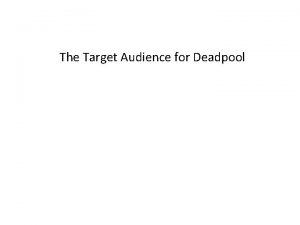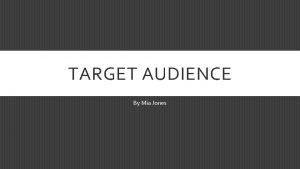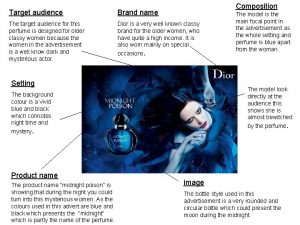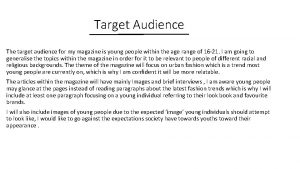Target Audience Who was the Target Audience Nightmare







- Slides: 7

Target Audience

Who was the Target Audience? �Nightmare at Ivy Court: �For this piece, we really wanted to try and imitate the classic horror films like “Friday the 13 th” and “Halloween”, and therefore we tried to direct our piece towards teenagers and young adults between the ages of 16 -24, which meant that, if we’d had the right tools, we could’ve produced a lot of fake gore to help keep the audience hooked with disgust and intrigue. The drama was also set to appeal more to men the women, as men seem to prefer films with mindless gore.

Who was the Target Audience? �Into the Darkness: �The target audience for our radio drama was very similar to that of Nightmare at Ivy Court, only we could range from ages 15 -35, as there would be next to no gore conveyed through the radio, minus a few references to blood, which allowed us to make our target audience slightly younger, and also we had the increased age cap on the drama as older people would potentially listen in whilst driving. The drama is still aimed at a more male audience than a female one.

Planning Influences �Nightmare at Ivy Court: �The target audience we had chosen meant we could really take the murder up a notch. Sadly, we lacked the resources to do so, but in our initial plan there was going to be a stabbing scene in which the lead female would be violently beaten and stabbed repeatedly by the mysterious figure. In this scene, we would’ve more than likely had a lot of fake blood, which we would’ve gotten away with thanks to our target audience age and the certification age limit of our opening. We met the needs of the audience by adding in a “murder” at the end of our trailer, which pointed to the fact that there would be gore and death in the film.

Planning Influences. � Into the Darkness: � With into the darkness, we had to ensure that our piece captured the attention of the audience and drew them into the story, however, we had to be very careful about the state of immersion that we got listeners into, because if a driver had been listening in to the drama, and for whatever reason this caused them to have an accident, then we could be held responsible. Likewise, we had to convey a certain, subtle level of blood and gore for adults to picture, but we had to make it subtle enough that younger listeners would be able to understand something bad was happening, but wouldn’t be traumatised by descriptive images of a bloodied man with a crazed look in his eye. We met this need by only briefly mentioning blood and a gun, so that younger listeners would be able to figure out that Mark was the “bad guy”, and adults would be able to realise that Mark had brutally killed Johnny and Simon and that he wasn’t the sane, secure, leading protagonist like they first thought, but is now the antagonist and has been all along, shown by the gun already placed inside his work bag.

Regulation Issues �Nightmare at Ivy Court: �We decided against having too much gore in our trailer, mainly because it was being sent off to examiners to be marked, but also because we still weren’t sure just how much gore we could get away with. It’s very hard to judge how much gore should be in a film to make people like it, for example, in “Friday the 13 th” there is gore, but people enjoy it because it’s so badly done. In a film like “saw” however, the gore is on a completely different scale, and yet some people still love it, so trying to find a balance is tricky stuff.

Regulation Issues �Into the Darkness: �The only real problem here was the sound effects we could and couldn’t use, for example, we weren’t allowed to use anything like a siren or a car horn, as they could risk distracting drivers and potentially causing an accident. Likewise, we also had to be careful with our radio broadcasts inside the story, as someone could have potentially tuned in at the time of a story and believe that there truly had been a mining accident, very similar to the reaction to the “War of the Worlds” radio broadcast, which left people in horror at the potential thought of aliens invading our planet and killing people mindlessly.













